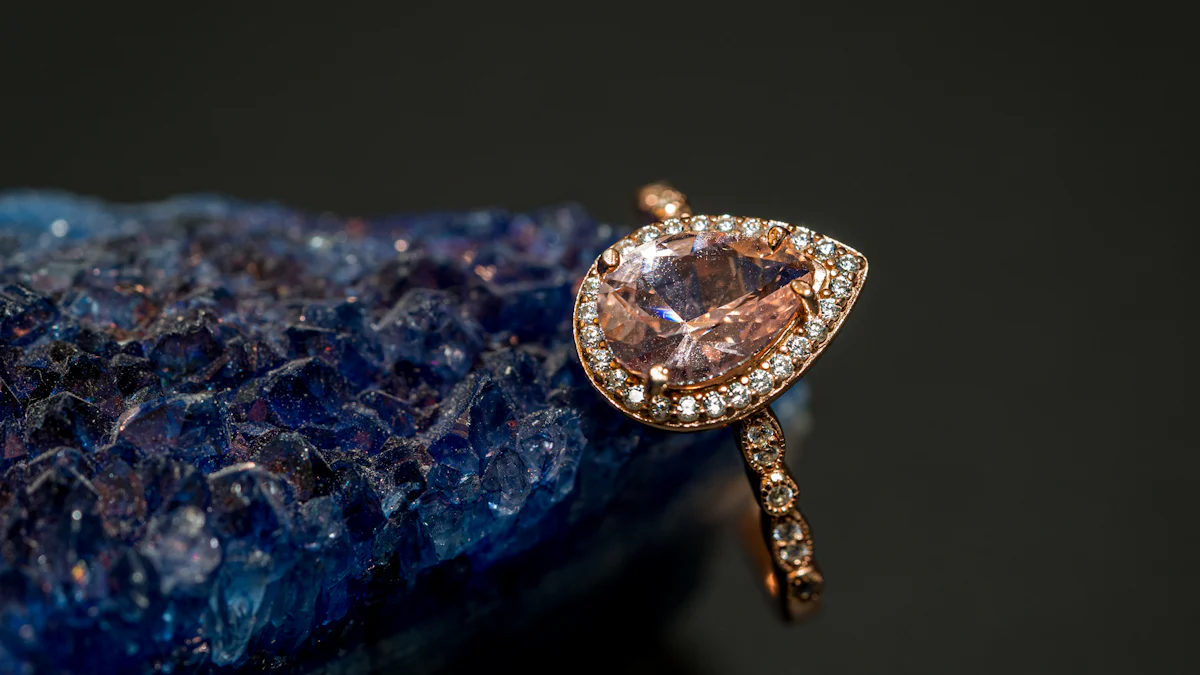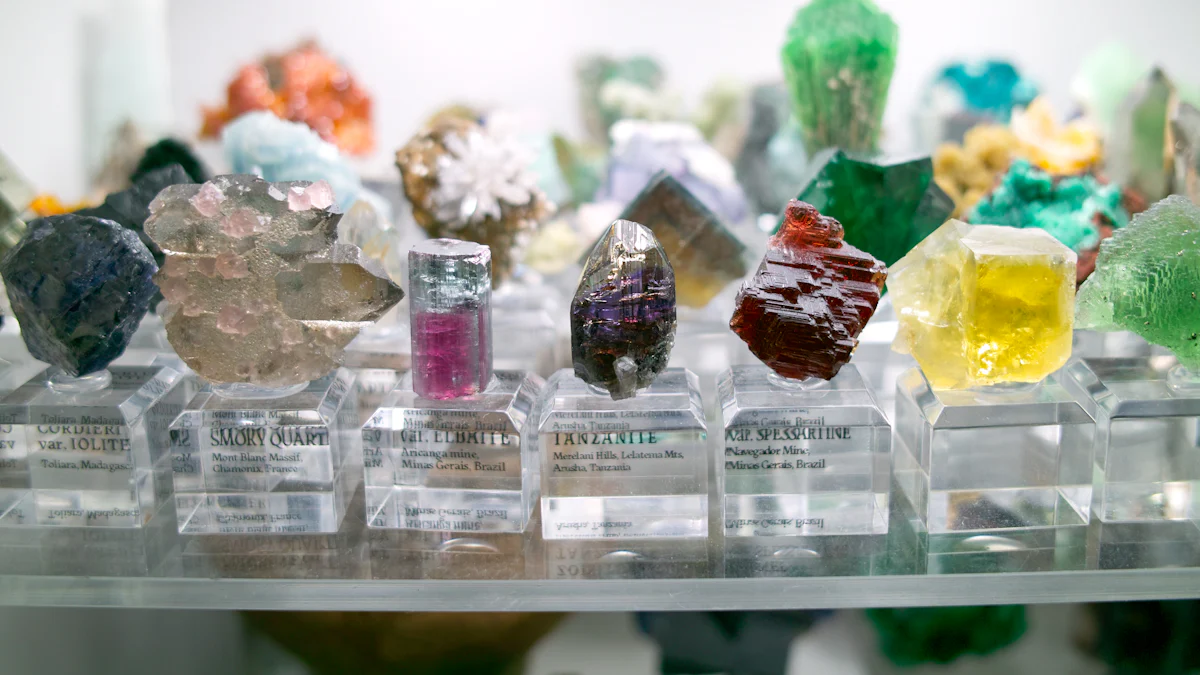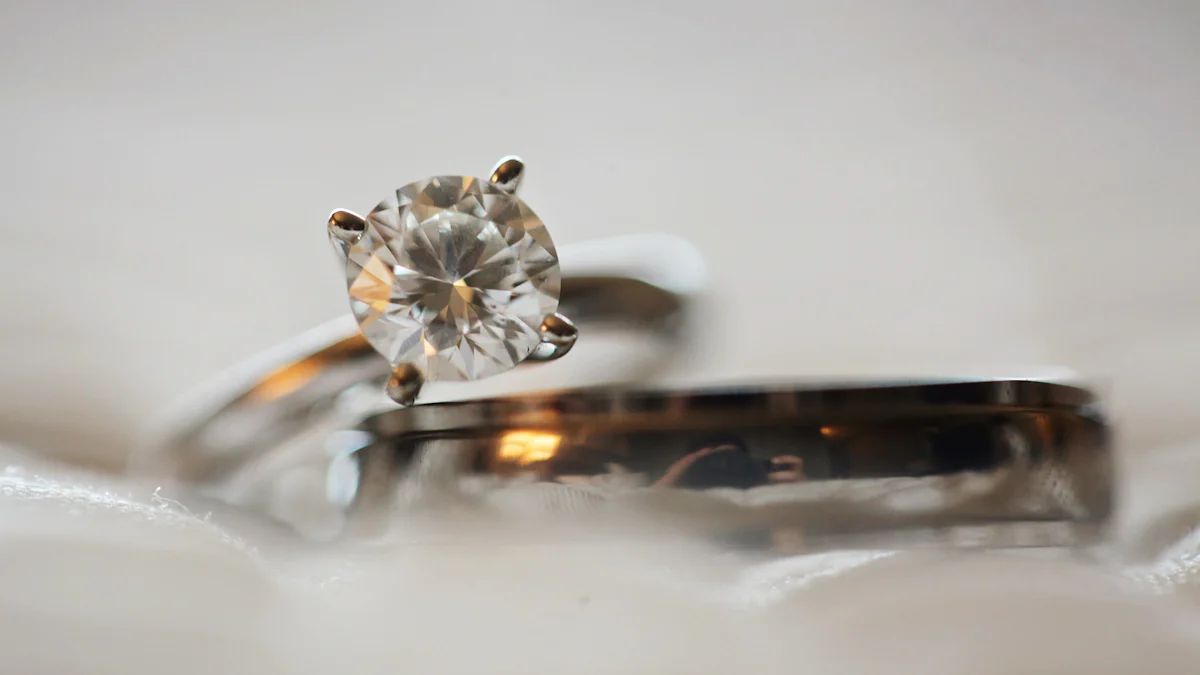Simulant Diamond: Key Properties You Should Know

Simulant diamonds, often mistaken for their natural counterparts, offer a fascinating alternative in the world of gemstones. These diamond simulants mimic the appearance of real diamonds but differ in composition and properties. Understanding these differences is crucial for you as a consumer. Simulant diamonds provide an ethical and cost-effective choice, appealing to those who prioritize sustainability and affordability. As you explore these options, recognizing their unique qualities will empower you to make informed decisions that align with your values and preferences.
Understanding Diamond Simulants

When you explore the world of gemstones, you will encounter diamond simulants. These are materials crafted to mimic the appearance of real diamonds. They serve a specific purpose by offering an affordable and ethical alternative to natural diamonds. Understanding simulated diamonds involves recognizing their unique characteristics and how they differ from genuine diamonds.
Definition and Purpose
Diamond simulants are not genuine diamonds. They are created to replicate the appearance of diamonds while differing in chemical composition and physical properties. Their primary purpose is to provide a cost-effective and sustainable option for those who desire the look of a diamond without the high price tag. By choosing simulant diamonds, you can enjoy the appearance of luxury while aligning with your budget and ethical values.
Common Types of Diamond Simulants
Several types of diamond simulants are popular in the market. Each type has distinct features that contribute to its appearance and quality.
Cubic Zirconia
Cubic zirconia is one of the most well-known diamond simulants. It is favored for its affordability and durability. This material is harder than many other gemstones, making it a durable choice for jewelry. Cubic zirconia offers a brilliant appearance that closely resembles that of a real diamond, making it a popular choice for those seeking quality at a lower cost.
Moissanite
Moissanite is another popular option among diamond simulants. This crystal, made from silicon carbide, is lab-created and known for its unique fire and brilliance. Moissanite has a slightly different refractive index compared to diamonds, which gives it a distinctive sparkle. Its appearance is often described as more fiery than that of a diamond, making it an attractive choice for those who appreciate a bit of extra dazzle.
White Sapphire
White sapphire is a natural simulant and a member of the corundum family. It is harder than cubic zirconia and moissanite, providing a durable option for jewelry. However, white sapphire may be less brilliant and sparkly compared to other simulants. Its appearance is more subdued, appealing to those who prefer a more understated look while still enjoying the quality of a natural gemstone.
By understanding these common types of diamond simulants, you can make informed decisions about which option best suits your needs and preferences. Each simulant offers a unique blend of quality and appearance, allowing you to choose the perfect alternative to a natural diamond.
Key Properties of Diamond Simulants
When you explore diamond simulants, understanding their key properties becomes essential. These properties help you evaluate the quality and performance of each simulant diamond, ensuring you make informed choices.
Hardness
Hardness is a critical factor when assessing diamond simulants. It determines how well a gemstone can resist scratches and maintain its appearance over time. On the Mohs scale, natural diamonds score a perfect 10, making them the hardest known material. Simulated diamonds, however, vary in hardness. For instance, cubic zirconia ranks around 8 to 8.5, while moissanite scores approximately 9. This difference means that while simulants are durable, they may not withstand wear and tear as effectively as natural diamonds. Understanding simulated diamonds' hardness helps you choose a simulant that aligns with your lifestyle and durability needs.
Brilliance
Brilliance refers to the sparkle and shine a gemstone exhibits when light reflects off its surface. Diamond simulants often aim to replicate the dazzling brilliance of real diamonds. Moissanite, for example, is renowned for its exceptional brilliance due to its high refractive index. This property gives moissanite a unique sparkle that some find even more captivating than that of a natural diamond. Cubic zirconia also offers impressive brilliance, though it may not match the fire of moissanite. Evaluating the optical characteristics of each simulant allows you to select one that meets your aesthetic preferences.
Color
Color plays a significant role in the appearance and quality of diamond simulants. While natural diamonds are graded on a color scale from D (colorless) to Z (light yellow or brown), simulants often come in a range of colors. Cubic zirconia is typically colorless, mimicking the look of a flawless diamond. Moissanite, on the other hand, may exhibit a slight yellow or gray tint, depending on the lighting. White sapphire, another simulant, tends to have a more subdued color, appealing to those who prefer a natural gemstone's understated elegance. By considering color, you can choose a simulant that complements your style and desired look.
Understanding these key properties of diamond simulants aids in evaluating quality and performance. Each simulant offers a unique blend of hardness, brilliance, and color, allowing you to find the perfect alternative to a natural diamond.
Durability
When considering diamond simulants, durability becomes a crucial factor. You want your jewelry to withstand daily wear and tear while maintaining its beauty. Each simulant offers varying levels of durability, which can influence your choice.
1. Hardness and Resistance to Scratches
Durability often relates to hardness, which measures a gemstone's ability to resist scratches. Natural diamonds, scoring a perfect 10 on the Mohs scale, set the standard for hardness. Simulants like cubic zirconia and moissanite, however, fall slightly lower on this scale. Cubic zirconia ranks around 8 to 8.5, while moissanite scores approximately 9. This means that while these simulants are quite hard, they may still scratch more easily than natural diamonds. Understanding this helps you choose a simulant that matches your lifestyle needs.
2. Structural Integrity
Beyond hardness, consider the structural integrity of the simulant. Some materials may be more prone to chipping or breaking under impact. For instance, cubic zirconia, though hard, can be brittle. Moissanite, with its robust structure, offers better resistance to chipping. White sapphire, being a natural gemstone, also provides good durability. Evaluating these aspects ensures you select a simulant that can endure your daily activities.
3. Longevity and Maintenance
Durability also involves how well a simulant maintains its appearance over time. Regular cleaning and care can preserve the brilliance and color of your gemstone. Moissanite, known for its excellent brilliance, retains its sparkle with minimal maintenance. Cubic zirconia may require more frequent cleaning to prevent cloudiness. By understanding the maintenance needs, you can keep your simulant looking its best for years.
Comparing Simulants to Real Diamonds

When you consider diamond simulants, understanding how they compare to real diamonds is essential. This comparison helps you make informed decisions based on your preferences and needs.
Visual Differences
The appearance of diamond simulants can closely mimic that of real diamonds. However, subtle differences exist. Cubic zirconia and moissanite are popular choices for their sparkle and brilliance. Moissanite, with its high refractive index, often exhibits a more fiery appearance than natural diamonds. Cubic zirconia, while brilliant, may lack the depth of sparkle found in real diamonds. These visual distinctions can influence your choice based on the appearance you desire.
Physical and Chemical Differences
Comparing physical properties between diamond simulants and real diamonds reveals notable differences. Real diamonds boast unmatched hardness, scoring a perfect 10 on the Mohs scale. Simulants like cubic zirconia and moissanite fall slightly lower, with cubic zirconia around 8 to 8.5 and moissanite at approximately 9. This means real diamonds offer superior durability and resistance to scratches. Chemically, diamond simulants differ from natural diamonds, affecting their performance and longevity. Understanding these differences aids in evaluating quality and performance.
Price and Value Considerations
Price plays a significant role when choosing between simulant diamonds and real diamonds. Diamond simulants, such as cubic zirconia and moissanite, are much more affordable than natural diamonds. This cost-effectiveness makes them an attractive option for those seeking the appearance of luxury without the high price tag. However, real diamonds hold greater value due to their rarity and enduring quality. When considering price and value, weigh the benefits of affordability against the prestige and investment potential of real diamonds.
By understanding these aspects, you can make an informed decision that aligns with your budget, quality expectations, and desired appearance. Whether you choose a simulant diamond or a real diamond, knowing these differences ensures you select the best option for your needs.
Advantages and Disadvantages of Diamond Simulants
When considering diamond simulants, you should weigh their benefits and limitations. Understanding these aspects will help you make informed decisions when selecting a diamond simulant that aligns with your needs and preferences.
Benefits of Using Simulants
Cost-Effectiveness
One of the most significant advantages of simulant diamonds is their cost-effectiveness. You can enjoy the appearance of luxury without the hefty price tag associated with natural diamonds. Materials like cubic zirconia and moissanite offer a similar sparkle and brilliance at a fraction of the cost. This affordability allows you to invest in larger or more intricate pieces without breaking the bank.
Ethical Considerations
Choosing simulated diamonds also aligns with ethical considerations. Natural diamond mining often raises environmental and ethical concerns. By opting for simulants, you support sustainable practices and reduce the demand for mined diamonds. This choice reflects a commitment to ethical consumption, allowing you to enjoy beautiful jewelry while minimizing your environmental impact.
Limitations of Simulants
Durability Concerns
While diamond simulants offer an attractive appearance, they may not match the durability of real diamonds. Natural diamonds are renowned for their unmatched hardness, scoring a perfect 10 on the Mohs scale. Simulants like cubic zirconia and moissanite fall slightly lower, making them more prone to scratches and wear over time. When selecting a diamond simulant, consider your lifestyle and how often you plan to wear the jewelry.
Perception and Prestige
The perception and prestige associated with natural diamonds can influence your decision. Real diamonds hold sentimental value and are often seen as symbols of status and luxury. While simulants can closely mimic the appearance of diamonds, they may lack the same level of prestige. Some people may perceive simulants as less valuable or desirable. When choosing between simulants and real diamonds, consider how much importance you place on societal perceptions and personal sentiment.
By understanding the advantages and disadvantages of diamond simulants, you can make a choice that aligns with your values, budget, and desired appearance. Whether you prioritize cost-effectiveness, ethical considerations, or durability, knowing these factors ensures you select the best option for your needs.
In summary, diamond simulants offer a compelling alternative to natural diamonds. They provide an affordable and ethical choice for those who appreciate the sparkle of diamonds without the high cost. When deciding between simulants and real diamonds, consider your budget, ethical values, and the importance of durability. Simulants like cubic zirconia and moissanite shine brightly and are cost-effective, but they lack the residual value and durability of natural diamonds. Your choice should reflect your personal preferences and lifestyle needs, ensuring you select the best option for your jewelry collection.
FAQ
What are diamond simulants?
Diamond simulants are materials designed to mimic the appearance of real diamonds. They differ in chemical composition and physical properties from natural diamonds. Common simulants include cubic zirconia, moissanite, and white sapphire. These alternatives offer a cost-effective and ethical choice for those who want the look of diamonds without the high price.
How do I choose the right simulated diamond?
When selecting a simulated diamond, consider factors like cut, shape, clarity, color, setting, durability, purpose, occasion, budget, and personal preference. By evaluating these aspects, you can confidently choose a simulant that aligns with your lifestyle and budget.
Are diamond simulants durable?
Simulants vary in durability. Natural diamonds score a perfect 10 on the Mohs scale, making them extremely hard. Simulants like cubic zirconia and moissanite rank slightly lower, meaning they may scratch more easily. Consider your lifestyle and how often you plan to wear the jewelry when choosing a simulant.
How do diamond simulants compare to real diamonds in terms of price?
Diamond simulants are significantly more affordable than natural diamonds. This affordability allows you to enjoy the appearance of luxury without the hefty price tag. Simulants like cubic zirconia and moissanite offer similar sparkle and brilliance at a fraction of the cost.
Can I tell the difference between a diamond simulant and a real diamond?
Visually, diamond simulants can closely resemble real diamonds. However, subtle differences exist. Moissanite often exhibits a more fiery appearance due to its high refractive index. Cubic zirconia may lack the depth of sparkle found in real diamonds. Understanding these distinctions can help you make an informed choice.
What should I consider when buying non-natural diamonds?
Pay attention to the wording used by sellers. Simulants and man-made diamonds have different properties and values. Understanding these differences ensures you make an informed decision when purchasing non-natural diamonds.
Are diamond simulants a good choice for bridal jewelry?
While simulants offer affordability and ethical benefits, real diamonds provide unmatched durability and value retention. Real diamonds symbolize precious relationships, making them a wise investment for bridal jewelry. Consider the long-term value and sentimental significance when choosing between simulants and real diamonds.
How do I maintain the appearance of my diamond simulant?
Regular cleaning and care can preserve the brilliance and color of your simulant. Moissanite retains its sparkle with minimal maintenance, while cubic zirconia may require more frequent cleaning to prevent cloudiness. Understanding the maintenance needs helps keep your simulant looking its best.
Why do people choose diamond simulants?
Many people opt for diamond simulants due to their affordability compared to natural diamonds of similar size, color, and clarity. Simulants provide an ethical and cost-effective alternative for those who appreciate the sparkle of diamonds without the high cost.
Should I seek professional assistance when choosing a simulated diamond ring?
Yes, choosing a simulated diamond ring can be challenging due to the wide range of stone options available. Seeking help from experienced sellers can aid in selecting the perfect simulant that suits your style and budget.
See Also
Exploring Essential Elements That Affect Diamond Ring Costs
A Comprehensive Guide to Engagement Ring Diamond Cuts
Tips for Choosing the Ideal Synthetic Diamond Bracelet

